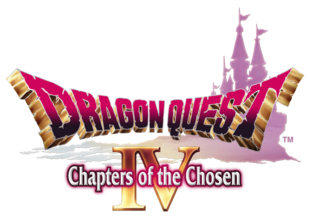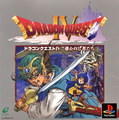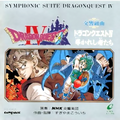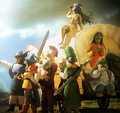Dragon Quest IV: Chapters of the Chosen: Difference between revisions
No edit summary |
SpartanSnake (talk | contribs) No edit summary |
||
| (12 intermediate revisions by 5 users not shown) | |||
| Line 1: | Line 1: | ||
{{ | {{Italic title}} | ||
{{Infobox VG | {{Infobox VG | ||
| title = Chapters of the Chosen | | title = Chapters of the Chosen | ||
| type = Main series games | | type = Main series games | ||
| developer = [[Chunsoft]]<br />Heartbeat, [[ArtePiazza]] ('' | | developer = [[Chunsoft]]<br />Heartbeat, [[ArtePiazza]] (''{{PS1}}'')<br />[[ArtePiazza]], Cattle Call(''{{DS}}'') | ||
| publisher = [[Enix]]<br /> [[Square Enix]] ('' | | publisher = [[Enix]]<br /> [[Square Enix]] (''{{DS}}'') | ||
| designer = [[ | | designer = [[Yuji Horii]] | ||
| image = [[Image:DQIV_Logo.png|center|310px]][[File:DQIV V Jump Art.png|310px]] | | image = [[Image:DQIV_Logo.png|center|310px]][[File:DQIV V Jump Art.png|310px]] | ||
| caption = | | caption = | ||
| Line 16: | Line 16: | ||
| ratings = {{vgratings|CERO=A ({{PS1}}, DS)|ESRB=E10+ ({{DS}})|OFLCA=PG}} | | ratings = {{vgratings|CERO=A ({{PS1}}, DS)|ESRB=E10+ ({{DS}})|OFLCA=PG}} | ||
| platforms = [[Nintendo Entertainment System]], {{Famicom}}, [[Sony PlayStation]], [[Nintendo DS]], [[Cell phone]] | | platforms = [[Nintendo Entertainment System]], {{Famicom}}, [[Sony PlayStation]], [[Nintendo DS]], [[Cell phone]] | ||
| media = 4-[[Wikipedia:megabit|megabit]] {{NES}} [[Wikipedia:cartridge (electronics)|cartridge]]<br/> [[Wikipedia:Compact disc|CD]] (PS1)<br/> [[Nintendo DS#Media specifications|Nintendo DS Game Card]] | | media = 4-[[Wikipedia:megabit|megabit]] {{NES}} [[Wikipedia:cartridge (electronics)|cartridge]]<br/> [[Wikipedia:Compact disc|CD]] ({{PS1}})<br/> [[Nintendo DS#Media specifications|Nintendo DS Game Card]] | ||
| requirements = | | requirements = | ||
| input = | | input = | ||
|series = | |series = {{Main Series}} | ||
}} | }} | ||
{{Translation|'''Dragon Quest IV'''|ドラゴンクエストIV 導かれし者たち|Doragon Kuesuto Fō Michibikareshi Monotachi|literally meaning; ''The People Who Are Shown the Way''}} is a role-playing game and the fourth installment of the {{Main Series}} video game series. The game was originally released for the {{NES}}, but has been remade several times for different systems. It begins the ''Tenkuu'' (''Celestial'') trilogy, known better as the '' | {{Translation|'''Dragon Quest IV'''|ドラゴンクエストIV 導かれし者たち|Doragon Kuesuto Fō Michibikareshi Monotachi|literally meaning; ''The People Who Are Shown the Way''}} is a role-playing game and the fourth installment of the {{Main Series}} video game series. The game was originally released for the {{NES}}, but has been remade several times for different systems. It begins the ''Tenkuu'' (''Celestial'') trilogy, known better as the ''[[Zenithia trilogy]]'' in English. | ||
It was originally released for the {{Famicom}} on February 11, 1990 in Japan. The North American version, titled | It was originally released for the {{Famicom}} on February 11, 1990 in Japan. The North American version, titled {{Dragon Warrior IV}}, was released for the {{NES}} in October 1992. | ||
==Setting== | ==Setting== | ||
''Dragon Quest IV'' is the first of the series to not be related to the [[Erdrick trilogy|lineage of Erdrick]]--the game is the first of a new trilogy revolving around the legend of a [[Zenithia trilogy|castle in the sky]] that watches over the world below. The world map is of a comparable size to that of | ''Dragon Quest IV'' is the first of the series to not be related to the [[Erdrick trilogy|lineage of Erdrick]]--the game is the first of a new trilogy revolving around the legend of a [[Zenithia trilogy|castle in the sky]] that watches over the world below. The world map is of a comparable size to that of {{III}}, but has no direct parallels to the real world in regards to the shape of the continents and nature of the kingdoms. | ||
==Plot== | ==Plot== | ||
The story in ''IV'' is a more character-focused tale centered around the lives of the chosen ones prior to and during their quest to prevent the resurrection of the ruler of evil, [[Estark]]. The first four chapters of the story are about the hero's companions and their own challenges and hardships. While they each travel with their own goals and dreams in mind, they all eventually discover the conspiracy of [[Psaro]] | The story in ''IV'' is a more character-focused tale centered around the lives of the chosen ones prior to and during their quest to prevent the resurrection of the ruler of evil, [[Estark]]. The first four chapters of the story are about the hero's companions and their own challenges and hardships. While they each travel with their own goals and dreams in mind, they all eventually discover the conspiracy of [[Psaro the Manslayer]] to drive the human race to extinction via Estark's hellish power. | ||
===Prologue=== | ===Prologue=== | ||
[[File:DQIV_Group.png|right|thumb|The characters of ''Dragon Quest IV''. From left to right: [[Kiryl]], [[Ragnar]], [[Alena]], the {{Hero 4}} (female and male), [[Borya]], [[Maya Mahabala]], [[Meena Mahabala]], and [[Torneko Taloon]]. |380px]] | |||
{{main|Dragon Quest IV Prologue{{!}}Prologue}} | {{main|Dragon Quest IV Prologue{{!}}Prologue}} | ||
Introduces The {{Hero 4}} and his/her friend [[Eliza]]. This portion of the story was introduced in the {{PlayStation}} | Introduces The {{Hero 4}} and his/her friend [[Eliza]]. This portion of the story was introduced in the {{PlayStation}} version, and became standard in later remakes. | ||
===Chapter 1: Ragnar McRyan and the Case of the Missing Children=== | ==={{DQ4 Chapter 1}}: Ragnar McRyan and the Case of the Missing Children=== | ||
{{main|Dragon Quest IV Chapter 1{{!}}Chapter 1}} | {{main|Dragon Quest IV Chapter 1{{!}}Chapter 1}} | ||
[[Ragnar McRyan]], one of the soldiers in the royal palace of [[Burland]], is sent by the king on a journey to find out why children are disappearing across the kingdom. | [[Ragnar McRyan]], one of the soldiers in the royal palace of [[Burland]], is sent by the king on a journey to find out why children are disappearing across the kingdom. | ||
===Chapter 2: Alena and the Journey to the Tourney=== | ==={{DQ4 Chapter 2}}: Alena and the Journey to the Tourney=== | ||
{{main|Dragon Quest IV Chapter 2{{!}}Chapter 2}} | {{main|Dragon Quest IV Chapter 2{{!}}Chapter 2}} | ||
[[Alena]], princess (Tsarevna in the Nintendo DS localization) of [[Zamoksva]], who slips out of the castle in hopes of seeing the world that exists beyond the castle walls. She is accompanied by the priest [[Kiryl]] and the mage [[Borya]]. | [[Alena]], princess (Tsarevna in the [[Nintendo DS]] localization) of [[Zamoksva]], who slips out of the castle in hopes of seeing the world that exists beyond the castle walls. She is accompanied by the priest [[Kiryl]] and the mage [[Borya]]. | ||
===Chapter 3: Torneko and the Extravagant Excavation=== | ==={{DQ4 Chapter 3}}: Torneko and the Extravagant Excavation=== | ||
{{main|Dragon Quest IV Chapter 3{{!}}Chapter 3}} | {{main|Dragon Quest IV Chapter 3{{!}}Chapter 3}} | ||
[[Torneko Taloon]] lives in [[Lakanaba]] with his [[Tessie Taloon|wife]] and [[Tipper Taloon|son]], and works part-time in the local weapon shop. He aims to become the best merchant in the world, and begins his chapter in search of a regional treasure that could help him accomplish his goal. | [[Torneko Taloon]] lives in [[Lakanaba]] with his [[Tessie Taloon|wife]] and [[Tipper Taloon|son]], and works part-time in the local weapon shop. He aims to become the best merchant in the world, and begins his chapter in search of a regional treasure that could help him accomplish his goal. | ||
===Chapter 4: Meena and Maya and the Mahabala Mystery=== | ==={{DQ4 Chapter 4}}: Meena and Maya and the Mahabala Mystery=== | ||
{{main|Dragon Quest IV Chapter 4{{!}}Chapter 4}} | {{main|Dragon Quest IV Chapter 4{{!}}Chapter 4}} | ||
[[Maya Mahabala]] the dancer and her younger sister [[Meena Mahabala]], the fortune teller, have left [[Laissez Fayre]] in search of vengeance against [[Balzack]], their [[Mahabala|father]]'s traitorous apprentice. | [[Maya Mahabala]] the dancer and her younger sister [[Meena Mahabala]], the fortune teller, have left [[Laissez Fayre]] in search of vengeance against [[Balzack]], their [[Mahabala|father]]'s traitorous apprentice. | ||
===Chapter 5: The Chosen=== | ==={{DQ4 Chapter 5}}: The Chosen=== | ||
{{main|Dragon Quest IV Chapter 5{{!}}Chapter 5}} | {{main|Dragon Quest IV Chapter 5{{!}}Chapter 5}} | ||
The {{Hero 4}} has been brought up by the inhabitants of a remote and [[Hidden Valley|nameless mountain village]]. But [[Psaro]] and his legions destroy the village, leaving only the hidden hero alive. The hero leaves in search of his seven companions, in the hopes of defeating Psaro and saving the world. | The {{Hero 4}} has been brought up by the inhabitants of a remote and [[Hidden Valley|nameless mountain village]]. But [[Psaro]] and his legions destroy the village, leaving only the hidden hero alive. The hero leaves in search of his seven companions, in the hopes of defeating Psaro and saving the world. | ||
===Chapter 6=== | ==={{DQ4 Chapter 6}}=== | ||
{{main|Dragon Quest IV Chapter 6{{!}}Chapter 6}} | {{main|Dragon Quest IV Chapter 6{{!}}Chapter 6}} | ||
{{DQ4 Chapter 6}} is a post-epilogue continuation of the game's storyline. Originally appearing in the {{PlayStation}} remake of ''Dragon Quest IV'', Chapter 6 offers a lengthy bonus dungeon, and the culmination of certain plot points that were left ambiguous in the original release. | {{DQ4 Chapter 6}} is a post-epilogue continuation of the game's storyline. Originally appearing in the {{PlayStation}} remake of ''Dragon Quest IV'', {{DQ4 Chapter 6}} offers a lengthy [[bonus dungeon]], and the culmination of certain plot points that were left ambiguous in the original release. | ||
==New features== | ==New features== | ||
===Artificial intelligence=== | ===Artificial intelligence=== | ||
In a bold move for an {{NES}} title, a significant portion of the game's memory was dedicated to an intricate artificial intelligence that controls party members during the fifth chapter. In the fifth chapter of the {{NES}} version of the game, the player no longer directly controls any of the previous characters; instead using the Tactics menu to deliver a loose set of instructions (Normal, Defensive, Offensive, Save MP, Use No MP, Try Out). The only character directly controlled is the Hero. All chapters except {{DQ4 Chapter 2}} also contain {{NPC}}, which travel with the player, but cannot be directly controlled. They act on their own, guided by the game's AI. | In a bold move for an {{NES}} title, a significant portion of the game's memory was dedicated to an intricate artificial intelligence that controls party members during the fifth chapter. In the fifth chapter of the {{NES}} version of the game, the player no longer directly controls any of the previous characters; instead using the Tactics menu to deliver a loose set of instructions (Normal, Defensive, Offensive, Save {{MP}}, Use No MP, Try Out). The only character directly controlled is the Hero. All chapters except {{DQ4 Chapter 2}} also contain {{NPC}}, which travel with the player, but cannot be directly controlled. They act on their own, guided by the game's AI. | ||
===Party expansion=== | ===Party expansion=== | ||
| Line 76: | Line 77: | ||
===Collectibles=== | ===Collectibles=== | ||
As the [[Erdrick | As the [[Erdrick trilogy]] revolved around amassing several artifacts to advance a game's progress, ''IV'' introduced collectibles to maintain the same sense of accomplishment while playing a more linear narrative. | ||
*[[Mini medal]]s are scattered throughout the world for the player to gather at their leisure, which can be exchanged for incredible equipment at the palace of the [[Medal King]]. | *[[Mini medal]]s are scattered throughout the world for the player to gather at their leisure, which can be exchanged for incredible equipment at the palace of the [[Medal King]]. | ||
*Items are now hidden in drawers, cabinets, and urns in addition to | *Items are now hidden in drawers, cabinets, and urns in addition to {{chest}}s. Contents range from stat boosting seeds to common item and small sums of [[gold]]. | ||
===[[Casino]]=== | ===[[Casino]]=== | ||
Building upon the gambling featured in the monster arenas of | Building upon the gambling featured in the monster arenas of {{III}}, the fourth game allows players to explore a large casino in the city of [[Endor]]. Redeemable tokens can be won at slot machines, poker, and monster betting, which can be spent on exclusive items and equipment. | ||
===Sequel connectivity=== | |||
{{DQ5}} has some references to ''Dragon Quest IV'', but is mostly an independent story that does not heavily rely on the previous entry. The adventure of the chosen is known only by a scant few individuals, which further separates the [[Zenithia trilogy]] from the Erdrick saga's heavy focus on in-game history and family lineage. | |||
== | ==Remakes and ports== | ||
''Dragon Quest IV'' was remade for the [[Sony PlayStation]] on November 22, 2001 in Japan. It was developed by Heartbeat and published by Enix. The remake was developed using {{DQ7}} 's 3D graphics engine. With this remake came new features; among them were a new chapter, a new character, a boom town reminiscent of {{VII}}'s, an [[Party Chat|inter-party talk]] command similar to {{Dragon Quest VII}}, and the ability to turn off the artificial intelligence for party members. The Enix of America Corporation originally planned to bring the remake to North America in 2002, but it was later cancelled due to Heartbeat closing its video game development operations. | |||
*The [[Bag]] has been added for unlimited item storage, which can carry up to 99 for each item. | *The [[Bag]] has been added for unlimited item storage, which can carry up to 99 for each item. | ||
*A ''Prologue'' chapter is added to introduce the | *A ''{{DQ4 Prologue}}'' chapter is added to introduce the {{Hero 4}} before chapter one begins, as well as a 6th chapter with a [[bonus dungeon]] and alternate ending. There is also a new Tactics feature to manually control your party in {{DQ4 Chapter 5}}. The PlayStation version uses the graphics engine from {{DQ7}}. | ||
*A [[Pioneer Town]] was added, similar to [[The Haven]] in {{DQ7}}. It is located in place of the [[Desert Bazaar]] (which in the {{NES}} | *A [[Pioneer Town]] was added, similar to [[The Haven]] in {{DQ7}}. It is located in place of the [[Desert Bazaar]] (which in the {{NES}} version served no purpose in Chapter 5). It is run by [[Hank Hoffman Jr.]] (who remains in the Inn at [[Mintos]] in the NES version). | ||
*A new dungeon, the [[Fungeon (Dragon Quest IV)|Fungeon]] was added in the "after-game", along with a new [[Zoom]] point within. The floors aside from the bosses room are taken from areas from the previous dungeons, the shop from Zalenagrad and areas from {{DQ7}}. | *A new dungeon, the [[Fungeon (Dragon Quest IV)|Fungeon]] was added in the "after-game", along with a new [[Zoom]] point within. The floors aside from the bosses room are taken from areas from the previous dungeons, the shop from Zalenagrad and areas from {{DQ7}}. | ||
*In the {{NES}} | *In the {{NES}} version, Hank Hoffman Jr. leaves the party after [[Alena]] and her companions join. In this version, he leaves immediately upon entering Mintos. | ||
*The first floor of the [[Imperial Pantry of Parthenia]] has a [[Thief's Key]] door blocking off the rest of the cave. To get it opened, [[Borya]] has to be recruited, which triggers a scene where Alena kicks the door down despite having the key. The {{NES}} version of the cave lacks the door and can be completed without recruiting Borya. | *The first floor of the [[Imperial Pantry of Parthenia]] has a [[Thief's Key]] door blocking off the rest of the cave. To get it opened, [[Borya]] has to be recruited, which triggers a scene where Alena kicks the door down despite having the key. The {{NES}} version of the cave lacks the door and can be completed without recruiting Borya. | ||
*The bonus Chapter 6, includes [[Psaro (Character)|someone]] becoming a playable character. | *The bonus {{DQ4 Chapter 6}}, includes [[Psaro (Character)|someone]] becoming a playable character. | ||
*While still uncontrollable during combat, healing spells known by [[Healie]], [[Laurel]] and [[Orifiela]] can be used manually out of battle. | *While still uncontrollable during combat, healing spells known by [[Healie]], [[Laurel]] and [[Orifiela]] can be used manually out of battle. | ||
*Only [[Eliza]] and [[Float-o-copier]]s can use the [[Morph]] spell, whereas in the NES | *Only [[Eliza]] and [[Float-o-copier]]s can use the [[Morph]] spell, whereas in the {{NES}} version, the Hero could also learn it. | ||
*In the {{NES}} | *In the {{NES}} version, [[Marquis de Léon]] dies after his defeat, whereas in the remakes, he reverts to his human form and forgets his time as a monster. | ||
*The player no longer loses [[Gold]] Coins after being defeated by Marquis de Léon in Chapter 4. | *The player no longer loses [[Gold]] Coins after being defeated by Marquis de Léon in Chapter 4. | ||
*The remakes have the [[Lightning staff]] available much sooner in the [[Vault of Vrenor]], as opposed to later in [[Castle Nadiria]]. | *The remakes have the [[Lightning staff]] available much sooner in the [[Vault of Vrenor]], as opposed to later in [[Castle Nadiria]]. | ||
| Line 129: | Line 106: | ||
*[[Thorn whip]]s were replaced by [[Divine dagger]]s. | *[[Thorn whip]]s were replaced by [[Divine dagger]]s. | ||
*[[Morning star]]s were replaced by [[Holy lance]]s. | *[[Morning star]]s were replaced by [[Holy lance]]s. | ||
*Instead of the [[Liquid metal shield]] which sold for 4000 coins, the [[casino]] sells [[ | *Instead of the [[Liquid metal shield]] which sold for 4000 coins, the [[casino]] sells [[Falcon sword]]s for 65,000 coins. | ||
*There's only one Liquid metal shield that you can get by trading in 52 mini medals to the medal king. | *There's only one Liquid metal shield that you can get by trading in 52 mini medals to the medal king. | ||
*[[Liquid metal armour]] now costs 35,000 | *[[Liquid metal armour]] now costs 35,000 [[gold]] coins, as opposed to the 15,000 in the {{NES}} version. | ||
*The | *The [[Gospel ring]] accessory is now included at the Pioneer town which is upgraded to a castle and is sold for 250,000 coins at the casino. | ||
*The Big | *[['The Big Book of Beasts']] is now included for the monster bestiary and the player will be rewarded 250,000 coins if they complete the list of monsters. | ||
[[File:DQ4-DS-OVERWORLD-SCREENSHOT.jpg|250px|thumb|Exploring the world in the {{DS}} version of ''Dragon Quest IV'']] | |||
On November 22, 2007, this PlayStation remake was ported to the [[Nintendo DS]]. No significant changes were made to the game's story, gameplay, or bonus features, aside from modifying the boom town's immigration aspects to reflect the lack of memory cards in the DS hardware and the calculation method for [[Alena]]'s [[Critical Hit]]s. The {{Fungeon 4}} ([[bonus dungeon]]) changed it's layout to random locations for each floor, whereas the {{PlayStation}} version was a mix of previous areas from the game and from {{DQ7}}. This portable version was released internationally in September of 2008, but without the party chat feature. This was due to Square Enix's uncertainty regarding the reception of the title, and the budget to translate the two-thirds of the script that the chat contained was slashed. However, the international release performed well and the budget for localization was expanded to allow the feature to be retained in {{V}} and {{VI}}. | |||
*The [[Nintendo DS]] remake uses nearly the same style as the {{PS1}} version, with some minor compression to account for the handheld's screen size. | |||
*The [[Pioneer Town]] lacks the variants of the {{PS1}} version due to replacing recruitable {{NPC}}s with ones that can be found after a certain point in game (see the article for more details). | |||
*The [[Nintendo DS]] remake uses nearly the same style as the | |||
*The [[Pioneer Town]] lacks the variants of the | |||
*The floors of the [[Fungeon (Dragon Quest IV)|Fungeon]] are made up of new designs rather than from previous areas in the game, as well as {{DQ7}}. | *The floors of the [[Fungeon (Dragon Quest IV)|Fungeon]] are made up of new designs rather than from previous areas in the game, as well as {{DQ7}}. | ||
*The {{DS}} uses 2 separate screens in the game, the top screen displaying the map and the heroes' battle information. | *The {{DS}} uses 2 separate screens in the game, the top screen displaying the map and the heroes' battle information. | ||
*Religious references that were removed from the {{NES}} | *Religious references that were removed from the {{NES}} version are now included in the game. | ||
*Name changes to Weapons, Armour, items. | *Name changes to Weapons, Armour, items. | ||
*Alena's [[Critical Hit]] formula was changed from ''level/256'' to ''(level(0.75))/256'', rendering her maximum chance at level 64 to be 19%. | |||
On April 7, 2014, the PlayStation remake was ported to iOS and Android compatible devices. This version features significantly sharper graphics than before, as well as a fully orchestrated soundtrack. No significant gameplay changes were made aside from yet another tweaking of the Tsarevna's [[Critical Hit]] formula, and a slight change adding a detour in the boom town development. The [[bonus dungeon]] layout from the {{DS}} port was retained. This version was released world wide on August 7, 2014, and most importantly restored the long-lost party chat to much critical acclaim. | |||
*The Android and iOS uses touch screen features and the game uses a portrait screen setting instead of the landscape screen. | *The Android and iOS uses touch screen features and the game uses a portrait screen setting instead of the landscape screen. | ||
*[[Zoom]] and [[Evac]]'s {{MP}} cost have been reduced to 1 MP each. | *[[Zoom]] and [[Evac]]'s {{MP}} cost have been reduced to 1 MP each. | ||
*The Pioneer Town's upgrade requirements have been slightly tweaked, requiring more townsfolk to be recruited per stage of development. | *The Pioneer Town's upgrade requirements have been slightly tweaked, requiring more townsfolk to be recruited per stage of development. | ||
*Alena's [[Critical Hit]] formula cap has been raised to 87, restoring the 25% chance from the {{NES}} and {{PSX}} versions. | |||
== | ==Soundtrack== | ||
[[File:Monster Battle Victory DQ IV group.png|right|border|450px|thumb|Splash art of the cast as they appear in ''[[Dragon Quest: Monster Battle Road Victory|Monster Battle Road Victory]]'']] | |||
[[Kōichi Sugiyama]] composed the music and directed all the associated spin-offs. This is the track listing of the Symphonic Suite: | |||
#''[[Overture]]'' (1:55) | |||
#''Minuet'' (3:07) | |||
#''Comrades'' (10:28) | |||
#''In a Town'' (8:16) | |||
#''Homeland ~ Wagon Wheels' March'' (5:58) | |||
#''Frightening Dungeons ~ Cursed Towers'' (5:19) | |||
#''Elegy ~ Mysterious Shrine'' (5:03) | |||
#''Balloon's Flight'' (4:32) | |||
#''Sea Breeze'' (4:31) | |||
#''The Unknown Castle'' (4:37) | |||
#''Battle for the Glory'' (7:51) | |||
#''The End'' (5:12) | |||
==Credits== | ==Credits== | ||
Original Famicom version | {| class="wikitable sortable" | ||
|+ Original Famicom version | |||
! Role | |||
! Staff | |||
|---------- | |||
|Scenario writer | |||
|Yuji Horii | |||
|---------- | |||
|Character designer | |||
|Akira Toriyama | |||
= | |---------- | ||
|Music composer | |||
|Koichi Sugiyama | |||
|---------- | |||
| rowspan="5 |Scenario assistant | |||
|Kazunori Orio | |||
|- | |||
= | |Tsuyoshi Asami | ||
|- | |||
|Fuminori Ishikawa | |||
|- | |||
= | |Shigeya Ueno | ||
|- | |||
|Sachiko Sugimura | |||
|---------- | |||
= | | rowspan="2 |Chief programmers | ||
|Hiroshi Naito | |||
|- | |||
|Manbu Yamana | |||
|---------- | |||
| rowspan="2 |Programmers | |||
|Narita Togo | |||
|- | |||
= | |Masaaki Okano | ||
|---------- | |||
| rowspan="6 |Assistant programmer | |||
|Kenichi Masuda | |||
= | |- | ||
|Kazuya Asano | |||
|- | |||
|Masumi Takimoto | |||
= | |- | ||
|Masayoshi Saitoh | |||
|- | |||
|Takahito Ikeda | |||
|- | |||
|Hiyoji Shinohara | |||
|---------- | |||
| rowspan="2 |Graphic designer | |||
|Takashi Yasuno | |||
|- | |||
= | |Satoshi Fudaba | ||
|---------- | |||
| rowspan="2 |Sound programmers | |||
|Masumi Takamoto | |||
|- | |||
|Tadashi Fukuzawa | |||
|---------- | |||
| rowspan="8 |Assistants | |||
|Rika Suzuki | |||
|- | |||
|Kenjiro Kano | |||
|- | |||
|Mariko Iida | |||
|- | |||
|Kazuhiro Kurimoto | |||
|- | |||
|Yuchi Kikumoto | |||
|- | |||
|Toshiaki Kamata | |||
|- | |||
|Eriko Yamakawa | |||
|- | |||
|Chiharu Ando | |||
|---------- | |||
| rowspan="2 |Assistant producer | |||
|[[Hiroyuki Takahashi]] | |||
|- | |||
|Sadao Yahagi | |||
|---------- | |||
|Director | |||
|Koichi Nakamura | |||
|---------- | |||
|Producer | |||
|Yukinobu Chida | |||
|---------- | |||
|Publisher | |||
|Yasuhiro Fukushima | |||
|} | |||
== | ==Trivia== | ||
* | *''IV'' is the only one of the original four games released for the [[Nintendo Entertainment System]] to not be remade for the [[Super Nintendo Entertainment System]], and the only title in the [[Zenithia trilogy]] to not have been originally developed for the 16-bit hardware | ||
==Gallery== | ==Gallery== | ||
| Line 227: | Line 247: | ||
{{ScreenshotGallery/End}} | {{ScreenshotGallery/End}} | ||
</center> | </center> | ||
===Box art=== | ===Box art=== | ||
<center><gallery> | <center><gallery> | ||
| Line 234: | Line 255: | ||
DQIV_DS_Box.png|[[Nintendo DS]] box art. | DQIV_DS_Box.png|[[Nintendo DS]] box art. | ||
</gallery></center> | </gallery></center> | ||
=== | |||
===Miscellaneous=== | |||
<center><gallery> | <center><gallery> | ||
Symphonic Suite Dragon Quest IV.png|Symphonic Suite. | Symphonic Suite Dragon Quest IV.png|Symphonic Suite. | ||
DQIV Famicom guide.png|Famicom guide. | DQIV Famicom guide.png|Famicom guide. | ||
DQIV V Jump guide.png|PlayStation guide | DQIV V Jump guide.png|PlayStation guide. | ||
DQIVPSArt.png|PlayStation art | DQIVPSArt.png|PlayStation art. | ||
DQIV PS Group.jpg|PlayStation group | DQIV PS Group.jpg|PlayStation group. | ||
File:Dragon Warrior IV logo.png|Logo of the cancelled localization of the psx remake. | File:Dragon Warrior IV logo.png|Logo of the cancelled localization of the psx remake. | ||
DQIVCast.png|Cast. | DQIVCast.png|Cast. | ||
| Line 249: | Line 271: | ||
DQIVCharacters.png | DQIVCharacters.png | ||
DQIV Random Encounter.png| | DQIV Random Encounter.png| | ||
Dragon Quest IV characters.png| | |||
DQIV CD Theater 1.png|''CD Theater''. | DQIV CD Theater 1.png|''CD Theater''. | ||
DQIV CD Theater 2.png|''CD Theater''. | DQIV CD Theater 2.png|''CD Theater''. | ||
Latest revision as of 22:02, 18 August 2024
| Main series games | |
|---|---|
| Chapters of the Chosen | |
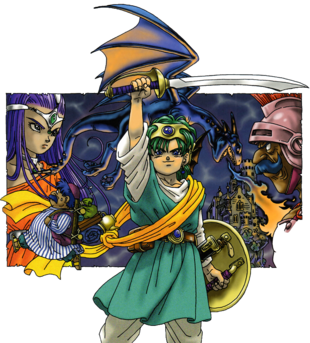
| |
| Developer(s) | Chunsoft Heartbeat, ArtePiazza (PS1) ArtePiazza, Cattle Call(DS) |
| Publisher(s) | Enix Square Enix (DS) |
| Designer(s) | Yuji Horii |
| Artist(s) | Akira Toriyama |
| Composer(s) | Kōichi Sugiyama |
| Series | Dragon Quest |
| Platform(s) | Nintendo Entertainment System, Famicom, Sony PlayStation, Nintendo DS, Cell phone |
| Release date(s) | Famicom/NES JP February 11, 1990 NA October 1992 PlayStation JP November 22, 2001 Nintendo DS JP November 22, 2007 NA September 16, 2008 EU September 12, 2008 AUS September 11, 2008 Android & iOS JP April 17, 2014 NA August 7, 2014 |
| Genre(s) | Console role-playing game |
| Mode(s) | Single-player |
| Rating(s) | CERO: A (PS1, DS) ESRB: E10+ (DS) OFLC: PG |
| Media | 4-megabit NES cartridge CD (PS1) Nintendo DS Game Card |
Dragon Quest IV (ドラゴンクエストIV 導かれし者たち Doragon Kuesuto Fō Michibikareshi Monotachi, literally meaning; The People Who Are Shown the Way) is a role-playing game and the fourth installment of the Dragon Quest video game series. The game was originally released for the NES, but has been remade several times for different systems. It begins the Tenkuu (Celestial) trilogy, known better as the Zenithia trilogy in English.
It was originally released for the Famicom on February 11, 1990 in Japan. The North American version, titled Dragon Warrior IV, was released for the NES in October 1992.
Setting[edit]
Dragon Quest IV is the first of the series to not be related to the lineage of Erdrick--the game is the first of a new trilogy revolving around the legend of a castle in the sky that watches over the world below. The world map is of a comparable size to that of III, but has no direct parallels to the real world in regards to the shape of the continents and nature of the kingdoms.
Plot[edit]
The story in IV is a more character-focused tale centered around the lives of the chosen ones prior to and during their quest to prevent the resurrection of the ruler of evil, Estark. The first four chapters of the story are about the hero's companions and their own challenges and hardships. While they each travel with their own goals and dreams in mind, they all eventually discover the conspiracy of Psaro the Manslayer to drive the human race to extinction via Estark's hellish power.
Prologue[edit]
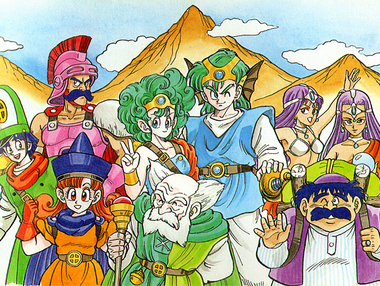
Introduces The Hero and his/her friend Eliza. This portion of the story was introduced in the PlayStation version, and became standard in later remakes.
Chapter 1: Ragnar McRyan and the Case of the Missing Children[edit]
Ragnar McRyan, one of the soldiers in the royal palace of Burland, is sent by the king on a journey to find out why children are disappearing across the kingdom.
Chapter 2: Alena and the Journey to the Tourney[edit]
Alena, princess (Tsarevna in the Nintendo DS localization) of Zamoksva, who slips out of the castle in hopes of seeing the world that exists beyond the castle walls. She is accompanied by the priest Kiryl and the mage Borya.
Chapter 3: Torneko and the Extravagant Excavation[edit]
Torneko Taloon lives in Lakanaba with his wife and son, and works part-time in the local weapon shop. He aims to become the best merchant in the world, and begins his chapter in search of a regional treasure that could help him accomplish his goal.
Chapter 4: Meena and Maya and the Mahabala Mystery[edit]
Maya Mahabala the dancer and her younger sister Meena Mahabala, the fortune teller, have left Laissez Fayre in search of vengeance against Balzack, their father's traitorous apprentice.
Chapter 5: The Chosen[edit]
The Hero has been brought up by the inhabitants of a remote and nameless mountain village. But Psaro and his legions destroy the village, leaving only the hidden hero alive. The hero leaves in search of his seven companions, in the hopes of defeating Psaro and saving the world.
Chapter 6[edit]
Chapter 6 is a post-epilogue continuation of the game's storyline. Originally appearing in the PlayStation remake of Dragon Quest IV, Chapter 6 offers a lengthy bonus dungeon, and the culmination of certain plot points that were left ambiguous in the original release.
New features[edit]
Artificial intelligence[edit]
In a bold move for an NES title, a significant portion of the game's memory was dedicated to an intricate artificial intelligence that controls party members during the fifth chapter. In the fifth chapter of the NES version of the game, the player no longer directly controls any of the previous characters; instead using the Tactics menu to deliver a loose set of instructions (Normal, Defensive, Offensive, Save MP, Use No MP, Try Out). The only character directly controlled is the Hero. All chapters except Chapter 2 also contain NPC, which travel with the player, but cannot be directly controlled. They act on their own, guided by the game's AI.
Party expansion[edit]
- Every chapter save the second includes a non-chosen party member who will assist the group temporarily during their travels together. Each is tied to a story element of the chapter and reflect that section of the story's tone.
- A Wagon was implemented to transport up to eight party members at the same time, allowing for battle configurations to be rearranged to suit any encounter at will. Certain dungeons will not allow the wagon to enter the area, however.
Collectibles[edit]
As the Erdrick trilogy revolved around amassing several artifacts to advance a game's progress, IV introduced collectibles to maintain the same sense of accomplishment while playing a more linear narrative.
- Mini medals are scattered throughout the world for the player to gather at their leisure, which can be exchanged for incredible equipment at the palace of the Medal King.
- Items are now hidden in drawers, cabinets, and urns in addition to chests. Contents range from stat boosting seeds to common item and small sums of gold.
Casino[edit]
Building upon the gambling featured in the monster arenas of III, the fourth game allows players to explore a large casino in the city of Endor. Redeemable tokens can be won at slot machines, poker, and monster betting, which can be spent on exclusive items and equipment.
Sequel connectivity[edit]
Dragon Quest V: Hand of the Heavenly Bride has some references to Dragon Quest IV, but is mostly an independent story that does not heavily rely on the previous entry. The adventure of the chosen is known only by a scant few individuals, which further separates the Zenithia trilogy from the Erdrick saga's heavy focus on in-game history and family lineage.
Remakes and ports[edit]
Dragon Quest IV was remade for the Sony PlayStation on November 22, 2001 in Japan. It was developed by Heartbeat and published by Enix. The remake was developed using Dragon Quest VII: Fragments of the Forgotten Past 's 3D graphics engine. With this remake came new features; among them were a new chapter, a new character, a boom town reminiscent of VII's, an inter-party talk command similar to Dragon Quest VII, and the ability to turn off the artificial intelligence for party members. The Enix of America Corporation originally planned to bring the remake to North America in 2002, but it was later cancelled due to Heartbeat closing its video game development operations.
- The Bag has been added for unlimited item storage, which can carry up to 99 for each item.
- A Prologue chapter is added to introduce the Hero before chapter one begins, as well as a 6th chapter with a bonus dungeon and alternate ending. There is also a new Tactics feature to manually control your party in Chapter 5. The PlayStation version uses the graphics engine from Dragon Quest VII: Fragments of the Forgotten Past.
- A Pioneer Town was added, similar to The Haven in Dragon Quest VII: Fragments of the Forgotten Past. It is located in place of the Desert Bazaar (which in the NES version served no purpose in Chapter 5). It is run by Hank Hoffman Jr. (who remains in the Inn at Mintos in the NES version).
- A new dungeon, the Fungeon was added in the "after-game", along with a new Zoom point within. The floors aside from the bosses room are taken from areas from the previous dungeons, the shop from Zalenagrad and areas from Dragon Quest VII: Fragments of the Forgotten Past.
- In the NES version, Hank Hoffman Jr. leaves the party after Alena and her companions join. In this version, he leaves immediately upon entering Mintos.
- The first floor of the Imperial Pantry of Parthenia has a Thief's Key door blocking off the rest of the cave. To get it opened, Borya has to be recruited, which triggers a scene where Alena kicks the door down despite having the key. The NES version of the cave lacks the door and can be completed without recruiting Borya.
- The bonus Chapter 6, includes someone becoming a playable character.
- While still uncontrollable during combat, healing spells known by Healie, Laurel and Orifiela can be used manually out of battle.
- Only Eliza and Float-o-copiers can use the Morph spell, whereas in the NES version, the Hero could also learn it.
- In the NES version, Marquis de Léon dies after his defeat, whereas in the remakes, he reverts to his human form and forgets his time as a monster.
- The player no longer loses Gold Coins after being defeated by Marquis de Léon in Chapter 4.
- The remakes have the Lightning staff available much sooner in the Vault of Vrenor, as opposed to later in Castle Nadiria.
- Boomerangs were replaced by Hunter's bows.
- Thorn whips were replaced by Divine daggers.
- Morning stars were replaced by Holy lances.
- Instead of the Liquid metal shield which sold for 4000 coins, the casino sells Falcon swords for 65,000 coins.
- There's only one Liquid metal shield that you can get by trading in 52 mini medals to the medal king.
- Liquid metal armour now costs 35,000 gold coins, as opposed to the 15,000 in the NES version.
- The Gospel ring accessory is now included at the Pioneer town which is upgraded to a castle and is sold for 250,000 coins at the casino.
- 'The Big Book of Beasts' is now included for the monster bestiary and the player will be rewarded 250,000 coins if they complete the list of monsters.
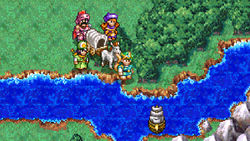
On November 22, 2007, this PlayStation remake was ported to the Nintendo DS. No significant changes were made to the game's story, gameplay, or bonus features, aside from modifying the boom town's immigration aspects to reflect the lack of memory cards in the DS hardware and the calculation method for Alena's Critical Hits. The Fungeon (bonus dungeon) changed it's layout to random locations for each floor, whereas the PlayStation version was a mix of previous areas from the game and from Dragon Quest VII: Fragments of the Forgotten Past. This portable version was released internationally in September of 2008, but without the party chat feature. This was due to Square Enix's uncertainty regarding the reception of the title, and the budget to translate the two-thirds of the script that the chat contained was slashed. However, the international release performed well and the budget for localization was expanded to allow the feature to be retained in V and VI.
- The Nintendo DS remake uses nearly the same style as the PS1 version, with some minor compression to account for the handheld's screen size.
- The Pioneer Town lacks the variants of the PS1 version due to replacing recruitable NPCs with ones that can be found after a certain point in game (see the article for more details).
- The floors of the Fungeon are made up of new designs rather than from previous areas in the game, as well as Dragon Quest VII: Fragments of the Forgotten Past.
- The DS uses 2 separate screens in the game, the top screen displaying the map and the heroes' battle information.
- Religious references that were removed from the NES version are now included in the game.
- Name changes to Weapons, Armour, items.
- Alena's Critical Hit formula was changed from level/256 to (level(0.75))/256, rendering her maximum chance at level 64 to be 19%.
On April 7, 2014, the PlayStation remake was ported to iOS and Android compatible devices. This version features significantly sharper graphics than before, as well as a fully orchestrated soundtrack. No significant gameplay changes were made aside from yet another tweaking of the Tsarevna's Critical Hit formula, and a slight change adding a detour in the boom town development. The bonus dungeon layout from the DS port was retained. This version was released world wide on August 7, 2014, and most importantly restored the long-lost party chat to much critical acclaim.
- The Android and iOS uses touch screen features and the game uses a portrait screen setting instead of the landscape screen.
- Zoom and Evac's MP cost have been reduced to 1 MP each.
- The Pioneer Town's upgrade requirements have been slightly tweaked, requiring more townsfolk to be recruited per stage of development.
- Alena's Critical Hit formula cap has been raised to 87, restoring the 25% chance from the NES and PSX versions.
Soundtrack[edit]
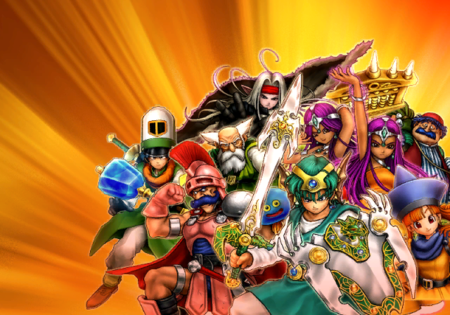
Kōichi Sugiyama composed the music and directed all the associated spin-offs. This is the track listing of the Symphonic Suite:
- Overture (1:55)
- Minuet (3:07)
- Comrades (10:28)
- In a Town (8:16)
- Homeland ~ Wagon Wheels' March (5:58)
- Frightening Dungeons ~ Cursed Towers (5:19)
- Elegy ~ Mysterious Shrine (5:03)
- Balloon's Flight (4:32)
- Sea Breeze (4:31)
- The Unknown Castle (4:37)
- Battle for the Glory (7:51)
- The End (5:12)
Credits[edit]
| Role | Staff |
|---|---|
| Scenario writer | Yuji Horii |
| Character designer | Akira Toriyama |
| Music composer | Koichi Sugiyama |
| Scenario assistant | Kazunori Orio |
| Tsuyoshi Asami | |
| Fuminori Ishikawa | |
| Shigeya Ueno | |
| Sachiko Sugimura | |
| Chief programmers | Hiroshi Naito |
| Manbu Yamana | |
| Programmers | Narita Togo |
| Masaaki Okano | |
| Assistant programmer | Kenichi Masuda |
| Kazuya Asano | |
| Masumi Takimoto | |
| Masayoshi Saitoh | |
| Takahito Ikeda | |
| Hiyoji Shinohara | |
| Graphic designer | Takashi Yasuno |
| Satoshi Fudaba | |
| Sound programmers | Masumi Takamoto |
| Tadashi Fukuzawa | |
| Assistants | Rika Suzuki |
| Kenjiro Kano | |
| Mariko Iida | |
| Kazuhiro Kurimoto | |
| Yuchi Kikumoto | |
| Toshiaki Kamata | |
| Eriko Yamakawa | |
| Chiharu Ando | |
| Assistant producer | Hiroyuki Takahashi |
| Sadao Yahagi | |
| Director | Koichi Nakamura |
| Producer | Yukinobu Chida |
| Publisher | Yasuhiro Fukushima |
Trivia[edit]
- IV is the only one of the original four games released for the Nintendo Entertainment System to not be remade for the Super Nintendo Entertainment System, and the only title in the Zenithia trilogy to not have been originally developed for the 16-bit hardware
Gallery[edit]
Title Screens[edit]
Box art[edit]
Original artwork of the Famicom release.
NES box art.
Playstation box art
Nintendo DS box art.
